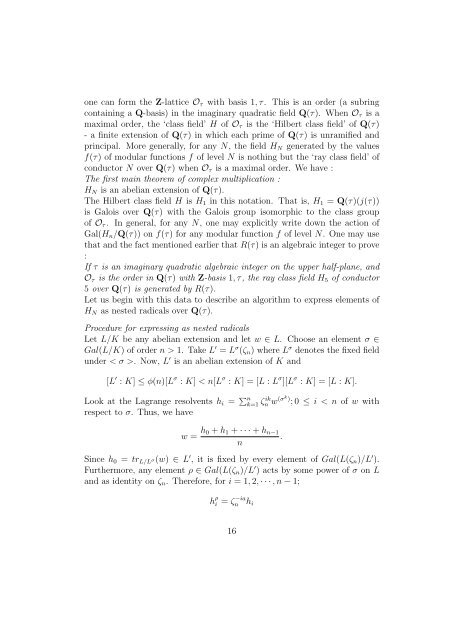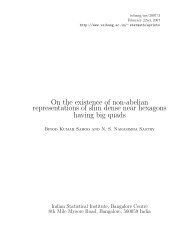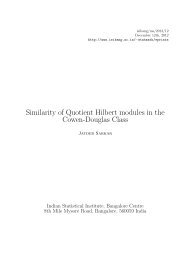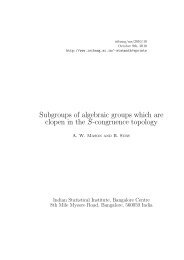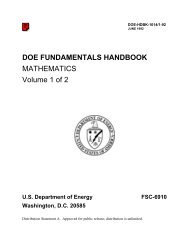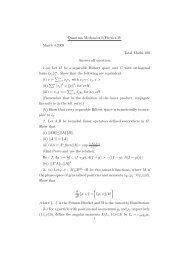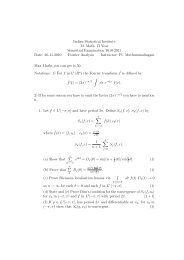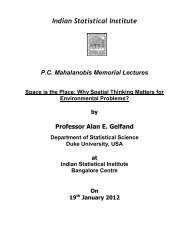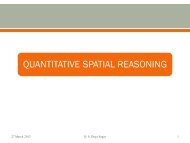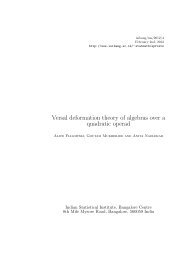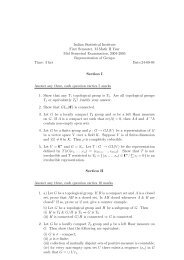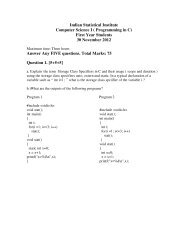Ramanujan's route to roots of roots - Indian Statistical Institute
Ramanujan's route to roots of roots - Indian Statistical Institute
Ramanujan's route to roots of roots - Indian Statistical Institute
Create successful ePaper yourself
Turn your PDF publications into a flip-book with our unique Google optimized e-Paper software.
one can form the Z-lattice O τ with basis 1, τ. This is an order (a subring<br />
containing a Q-basis) in the imaginary quadratic field Q(τ). When O τ is a<br />
maximal order, the ‘class field’ H <strong>of</strong> O τ is the ‘Hilbert class field’ <strong>of</strong> Q(τ)<br />
- a finite extension <strong>of</strong> Q(τ) in which each prime <strong>of</strong> Q(τ) is unramified and<br />
principal. More generally, for any N, the field H N generated by the values<br />
f(τ) <strong>of</strong> modular functions f <strong>of</strong> level N is nothing but the ‘ray class field’ <strong>of</strong><br />
conduc<strong>to</strong>r N over Q(τ) when O τ is a maximal order. We have :<br />
The first main theorem <strong>of</strong> complex multiplication :<br />
H N is an abelian extension <strong>of</strong> Q(τ).<br />
The Hilbert class field H is H 1 in this notation. That is, H 1 = Q(τ)(j(τ))<br />
is Galois over Q(τ) with the Galois group isomorphic <strong>to</strong> the class group<br />
<strong>of</strong> O τ . In general, for any N, one may explicitly write down the action <strong>of</strong><br />
Gal(H n /Q(τ)) on f(τ) for any modular function f <strong>of</strong> level N. One may use<br />
that and the fact mentioned earlier that R(τ) is an algebraic integer <strong>to</strong> prove<br />
:<br />
If τ is an imaginary quadratic algebraic integer on the upper half-plane, and<br />
O τ is the order in Q(τ) with Z-basis 1, τ, the ray class field H 5 <strong>of</strong> conduc<strong>to</strong>r<br />
5 over Q(τ) is generated by R(τ).<br />
Let us begin with this data <strong>to</strong> describe an algorithm <strong>to</strong> express elements <strong>of</strong><br />
H N as nested radicals over Q(τ).<br />
Procedure for expressing as nested radicals<br />
Let L/K be any abelian extension and let w ∈ L. Choose an element σ ∈<br />
Gal(L/K) <strong>of</strong> order n > 1. Take L ′ = L σ (ζ n ) where L σ denotes the fixed field<br />
under < σ >. Now, L ′ is an abelian extension <strong>of</strong> K and<br />
[L ′ : K] ≤ φ(n)[L σ : K] < n[L σ : K] = [L : L σ ][L σ : K] = [L : K].<br />
Look at the Lagrange resolvents h i = ∑ n<br />
k=1 ζ ik<br />
n w (σk) ; 0 ≤ i < n <strong>of</strong> w with<br />
respect <strong>to</strong> σ. Thus, we have<br />
w = h 0 + h 1 + · · · + h n−1<br />
.<br />
n<br />
Since h 0 = tr L/L σ(w) ∈ L ′ , it is fixed by every element <strong>of</strong> Gal(L(ζ n )/L ′ ).<br />
Furthermore, any element ρ ∈ Gal(L(ζ n )/L ′ ) acts by some power <strong>of</strong> σ on L<br />
and as identity on ζ n . Therefore, for i = 1, 2, · · · , n − 1;<br />
h ρ i = ζn<br />
−ia h i<br />
16


